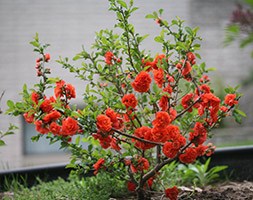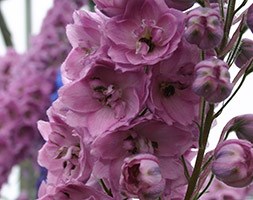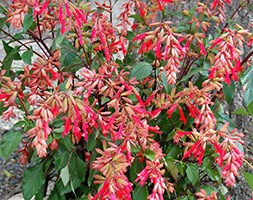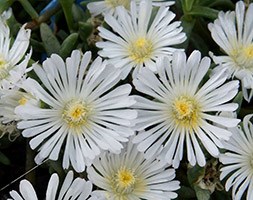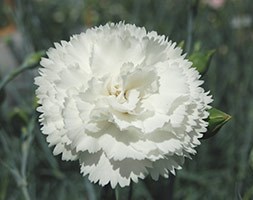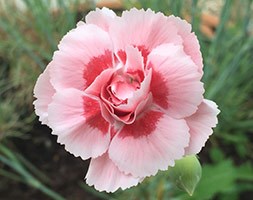New products at Crocus
by Sarah - February 21st, 2016.Filed under: Crocus, New Products.
New items today at Crocus
Chaenomeles speciosa ‘Orange Storm’ (PBR) (flowering quince) £14.99
Position: full sun or partial shade Soil: moderately fertile, well-drained soil Rate of growth: fast-growing Flowering period: March to May Hardiness: fully hardy A new form of flowering quince, which stands out from the crowd with its large bright orange flowers. This easy to grow deciduous shrub will make an undemanding addition to a mixed border, but can also be used to create a informal hedge. The slender, thorn-free stems can also be tied onto a framework and trained flat(ish) against a wall. Garden care: After flowering prune side shoots to five or six leaves and remove crossing or ill-placed stems. Once established remove excess growth in late spring or summer and cut back all side shoots to two or three leaves.
Delphinium ‘Dusky Maidens (New Millennium Series)’ (delphinium) £7.99
Position: full sun Soil: fertile, well-drained soil Rate of growth: average Flowering period: June and July Hardiness: fully hardy Forming part of the New Millennium Series, this delphinium in noted for its sturdy growth and tall, stout stems that are clothed in brown-eyed dusky pink flowers. An excellent addition for the mixed or herbaceous border, where it will add height, colour and vertical interest in summer. If you remove the spent spike after the flowers have faded, you may even get a second, less lavish flush later in the year. Garden care: For best results, stake with bamboo canes as they start to shoot upwards in mid-spring, and protect young foliage against slug and snail damage. During the growing season, apply a balanced liquid fertiliser every 2-3 weeks and wearing gloves cut back the faded flower-stems to a flowering side-shoot to encourage repeat flowering. At the end of autumn cut back and compost the faded flower stems.
Salvia Ember’s Wish = ‘SAL 0101’ (PBR) (sage) £6.99
Position: full sun to lightly dappled shade Soil: humus-rich, well-drained soil Rate of growth: average Flowering period: July to October Flower colour: magenta pink Hardiness: frost hardy (may need winter protection) A sport of the popular ‘Wendy’s Wish’, with upright stems topped from midsummer with loose clusters of fiery coral-orange flowers. It looks wonderful when teamed with yellow flowering perennials where it will quickly fill a gap towards the middle of the border. Garden care: To prolong flowering remove the flower spikes as soon they start to fade. Apply a generous 5-7cm (2-3in) mulch of well-rotted garden compost or manure around the base of the plant in spring.
climbing strawberry ‘Mount Everest’ (strawberry everbearer ) £6.99
Position: full sun Soil: any soil Rate of growth: fast-growing Other features: tasty, orange-red fruit (mid-June to mid-July) Cropping times may be brought forward or extended if you are growing them in a greenhouse or cloche tunnel. Hardiness: fully hardy This unique climbing strawberry produces long runners upto 1 meter in length thats ( upto 3 foot 2in length) that can be tied on a a obelisk. Garden care: Prepare the ground well before planting. Clear all the weeds and dig in lots of well-rotted manure. When planting out, space the plants at 45cm intervals with 75cm between each row and apply a generous layer of mulch around the base of the plants, being careful to avoid the crown. If training onto a support, tie them in as they start to grow and keep the runners off the ground. If you want to grow them in the more conventional way and let them trail along the ground, then put a thick layer of straw or use strawberry mats under the plants to stop the fruit touching the soil when they are starting to form. Sheets of black plastic mulch can also be used, and it will also help retain soil moisture, reduce weeds and encourage early cropping.
Delosperma White Wonder = ‘Wowdw7’ (Wheels of Wonder Series) (PBR) (ice plant) £6.99
Position: full sun Soil: well-drained, sandy Rate of growth: average Flowering period: May to October Hardiness: fully hardy The contrast between the yellow-eyed white flowers and the rich green foliage is really fresh, and as they appear over a really long period, it is a must for sunny spots with freely draining soils. Once it has settled in to the right spot, it is one of those plants that you can just forget abot as it will hardly ever need watering. Garden care: Avoid overwatering – particularly in winter.
Dianthus ‘Haytor White’ (Pink) £2.99
Position: full sun Soil: well-drained, neutral to alkaline soil Rate of growth: average Flowering period: June to September Hardiness: fully hardy Pure white petals, which look as though they have been clipped with pinking shears, form showy 6cm wide flowers that appear for months on end from early summer. These have a good scent and make excellent and long-lived cut flowers. Firm favourites for the cottage garden, where they will thrive in a sunny spot. Garden care: Incorporate lots of well-rotted manure or garden compost into the planting hole. Apply a balanced fertiliser in spring and deadhead to prolong flowering. Try taking cuttings in July and early August. Fill a small seed tray with coarse horticultural sand and water it well. Take the cuttings in the cool of the day, choosing non-flowering side shoots about two inches (5cm) in length. If there are flower buds, pick them off. Trim the cuttings below a node (where the leaf joint is) and remove or reduce any large leaves to lessen transpiration. Plunge them into the sand so that two-thirds of the cutting is submerged and place the tray in a cool, shady position for several weeks. Then pot up individually into compost, such as John Innes no 1. You can also leave your cuttings in situ until next spring, although they will need protection from frost.
Dianthus ‘Doris’ (pink) £2.99
Position: full sun Soil: well-drained, neutral to alkaline soil Rate of growth: average Flowering period: June to September Hardiness: fully hardy A popular modern pink with clove-scented, double, pale pink flowers with red centres from early summer through to autumn. The fine, silvery-green foliage makes a lovely frame for the masses of flowers. Old-fashioned by reputation, and short-liv ed by nature, this is none the less a robust plant with a long flowering period that will tolerate a wide range of conditions. It is best planted towards the front of a perennial border or rock garden, or in a pot. Garden care: Incorporate lots of well-rotted manure or garden compost into the planting hole. Apply a balanced fertiliser in spring and deadhead to prolong flowering. Try taking cuttings in July and early August. Fill a small seed tray with coarse horticultural sand and water it well. Take the cuttings in the cool of the day, choosing non-flowering side shoots about two inches (5cm) in length. If there are flower buds, pick them off. Trim the cuttings below a node (where the leaf joint is) and remove or reduce any large leaves to lessen transpiration. Plunge them into the sand so that two-thirds of the cutting is submerged and place the tray in a cool, shady position for several weeks. Then pot up individually into compost, such as John Innes no 1. You can also leave your cuttings in situ until next spring, although they will need protection from frost.







